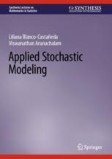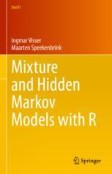Search
Search Results
-
Continuous-Time Markov Chain Modeling
As we mentioned earlier, the Russian mathematician Andrei Andreyevich Markov (1856–1922) introduced sequences of values of a random variable in which...
-
A copula formulation for multivariate latent Markov models
We specify a general formulation for multivariate latent Markov models for panel data, where outcomes are possibly of mixed-type (categorical,...

-
Variable Selection for Hidden Markov Models with Continuous Variables and Missing Data
We propose a variable selection method for multivariate hidden Markov models with continuous responses that are partially or completely missing at a...

-
Hidden Markov models for longitudinal rating data with dynamic response styles
This work deals with the analysis of longitudinal ordinal responses. The novelty of the proposed approach is in modeling simultaneously the temporal...

-
Multivariate Hidden Markov Models
This chapter provides three extended example analyses, applying hidden Markov models to multivariate time series. The first example (Sect. 6.1)...
-
Hidden Markov Models
This chapter introduces hidden Markov models (HMMs), which can be viewed as an extension of mixture models, in which a unit of observation (e.g., a...
-
Bayesian Analysis of First-Order Markov Models for Autocorrelated Binary Responses
In many clinical trials, patient outcomes are often binary-valued which are measured asynchronously over time across various dose levels. To account...

-
Markov switching stereotype logit models for longitudinal ordinal data affected by unobserved heterogeneity in responding behavior
When asked to assess their opinion about attitudes or perceptions on Likert-scale, respondents often endorse the midpoint or extremes of the scale...

-
Discrete-Time Markov Chain
Markov chains serve as one of the most important methods in the application of probability theory to real-world models involving uncertainty. Markov...
-
Markov switching quantile regression models with time-varying transition probabilities
Markov switching models are widely used in the time series field for their ability to describe the impact of latent regimes on the behaviour of...

-
The Latent Markov Chain Model
The latent Markov chain model is discussed, and the relationship between the model and the latent class model is considered. An ML estimation...
-
A hybrid landmark Aalen-Johansen estimator for transition probabilities in partially non-Markov multi-state models
Multi-state models are increasingly being used to model complex epidemiological and clinical outcomes over time. It is common to assume that the...

-
Melded Integrated Population Models
Integrated population models provide a framework for assimilating multiple datasets to understand population dynamics. Understanding drivers of...

-
Estimation and bootstrap for stochastically monotone Markov processes
The Markov property is shared by several popular models for time series such as autoregressive or integer-valued autoregressive processes as well as...

-
Analysis of stochastic gradient descent in continuous time
Stochastic gradient descent is an optimisation method that combines classical gradient descent with random subsampling within the target functional....

-
Tempered expectation-maximization algorithm for the estimation of discrete latent variable models
Maximum likelihood estimation of discrete latent variable (DLV) models is usually performed by the expectation-maximization (EM) algorithm. A...

-
A causal hidden Markov model for assessing effects of multiple direct mail campaigns
We propose assessing the causal effects of a dynamic treatment in a longitudinal observational study, given observed confounders under suitable...
-
Bayesian Analysis of Proportions via a Hidden Markov Model
Time series of proportions arise in many contexts. In this paper, we consider a hidden Markov model (HMM) to describe temporal dependence in such...

-
Hidden Markov model with missing emissions
In a Hidden Markov model (HMM), from hidden states, the model generates emissions that are visible. Generally, the problems to be solved by such...

-
Competing Risks Modeling by Extended Phase-Type Semi-Markov Distributions
We present competing risks models within a semi-Markov process framework via the semi-Markov phase-type distribution. We consider semi-Markov...

